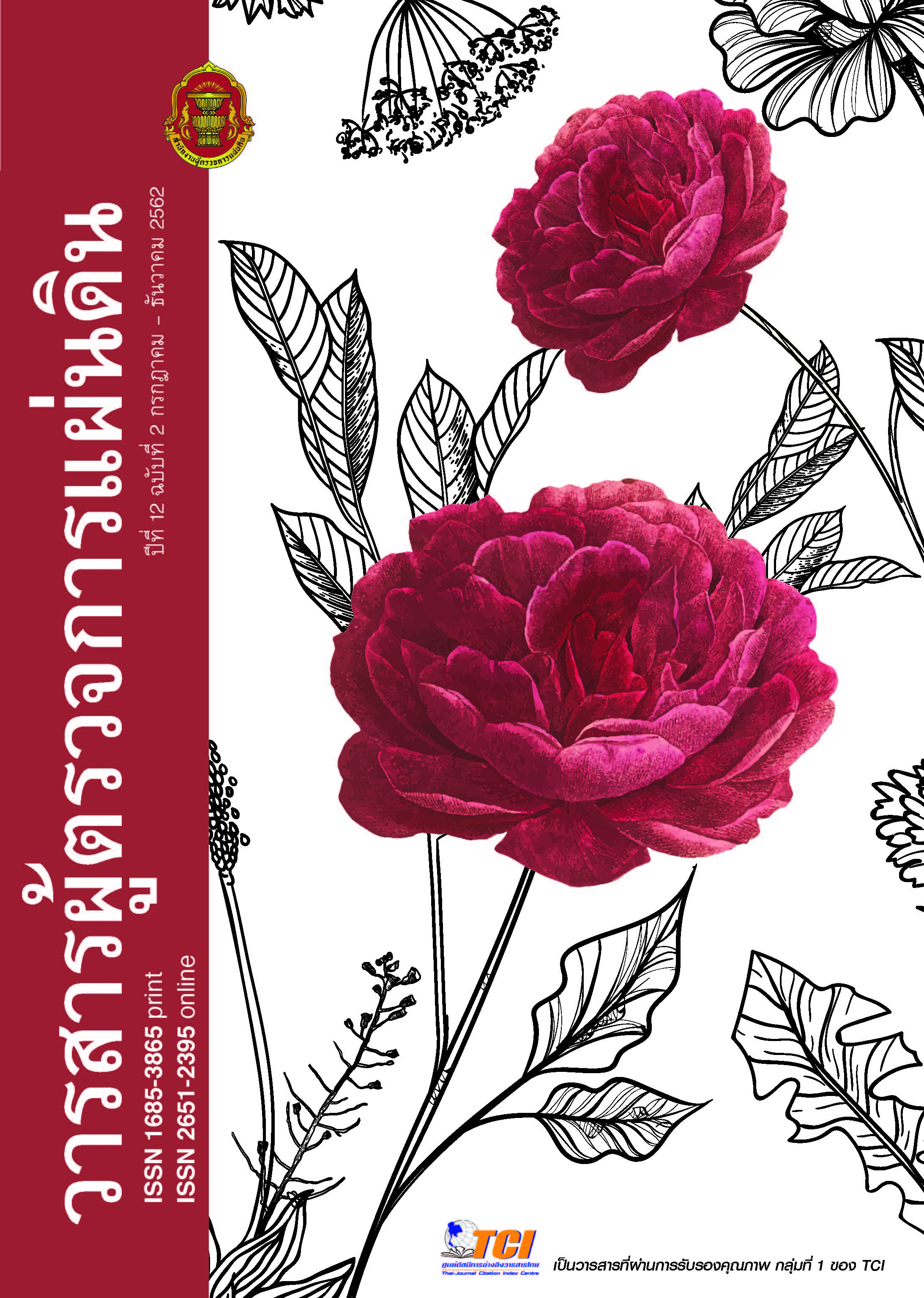A Model of the Implementation of Repatriation of Forest Policy: A study of Mangrove Forest Areas in Central Thailand
Keywords:
Policy Implementation, Repatriation of Forest Policy, Mangrove Forest, Central ThailandAbstract
This research article aimed to study the situation and problems of the implementation of repatriation of forest policy of the mangrove forest area in central region of Thailand, and to propose the proper model of the implementation of repatriation of forest policy for the context of the mangrove area forest in central Thailand.
This research employed the qualitative research by documentary research, non-participant observation and in-depth interviews with key informants, namely, the government officials related to the implementation of repatriation of forest policy, community leaders and villagers, and academics. This utilized the purposive selection; a total of 15 people, and the inductive analysis.
The major findings revealed that the policy can actually respond to solving problems in the area due to being able to retrieved a large amount of forest back. However, the policy confronted many practical problems, such as insufficient forest restoration budgets, delayed bottom-up communications, and overlapping cabinet resolutions, etc. For the proper model of the implementation of repatriation of forest policy for the context of the mangrove area forest, in addition to the main 6 factors include 1) policy objectives 2) policy resources 3) interorganizational communication and enforcement activities
4) characteristics of implementing agencies, 5) social, economic and political conditions, and 6) disposition and cooperation the implementers applied from the concept of Van Meter and Van Horn and Pressman and Wildavsky, the researcher found the related time-clause factors in policy implementation, networking, and participation, including the state factors, or conditions of natural resources and the environment as well. One important recommendation from research show that the state provide opportunities for all sectors to become more involved in the model of share substantial resource management.
References
Banphot Meknitikun. (2011). Kānnamnayōbāikānkhūapkhum ʻākhānpaipatibatkhō̜ng’ongkānbō̜rihānsūa n Tambonnaikhētparimonthon. [The Implementation of Building Control Policy by Subdistrict Administration Organizations in the Environs of Bangkok]. (Ph.D. Dissertation Department of Public Administration). University of Ramkhamhaeng, Thailand.
Barrett, S., and Fudge, C. (1981). Policy and action. London: Methuen.
Chiraphan Muatchan. (2012). Sathānkānkānbukrukpāchāilēnkhō̜ngprathedthai.
[Situation of Mangrove Forest intrusion in Thailand]. ʻĒkkasānwichākān Chabapthī 3/2555. Bangkok:
Department of Marine and Coastal Resources.
Chompoonuch Hunnak. (2017). Kānbō̜rikānsāthāranamaiphư̄arapchaiphonlamư̄ang. [New Public Services for Serving Citizens]. Journal of Humanities and Social Sciences Review, 19, 1, 125-140.
Department of Marine and Coastal Resources. (2016). Rāingānpračhampī 2559.
[Annual report 2559]. Bangkok: Department of Marine and Coastal Resources.
Edwards, G.C. (1980). Implementing Public Policy. Washington D.C.: Congressional Quarterly Press.
Hogwood, B.W. and Gunn, L.A. (1984). Policy analysis for the real world. London: Oxford University Press.
Kritin Chansondhima and Orathai Intachaiwong. (2016). Kānmīsūanrūamnaikānčhatkān Sapphayākō̜nthammachātyāngsomdunlæyangyư̄n: Sưksāchapho̜kranī Pāchumchonbānkhlō̜nghūaiwāi ʻAmphœ̄mǣpœ̄n Čhatwatnakornsawan. [Guidelines for participation in natural resource management balance and sustainability. Case study: Community Ban Khlong Huai Wai, Mae Poen, Nakhon Sawan]. Journal of Thai Ombudsman, 9, 1, 58-79.
Land Watch. (2018, July 3). Pœtraingan Land Watch Phonkrathopkhamsangkhotcha. Hoksipsi/57, Hoksiphok/hasipchet læphænmæbotpamai. [Open the Report ‘Land Watch’ Impact of National Council for Peace and Order 64/57, 66/57 and Forest Master Plan]. Retrieved from https://tlhr2014.wordpress.com/
so̜ngphansipha/kao/yisipso̜ng/ landwatch_ report/
Mazmanian, D.A. and Sabatier, P. A. (1989). Implementation and Public Policy. Glenview, Maryland: University Press of America.
Nakamura, R.T. and Smallwood, F. (1980). The Politics of Policy Implementation. New York: St. Martin's Press.
Ostrom, Elinor. (2010). Beyond Markets and States: Polycentric Governance of Complex Economic Systems. American Economic Review. 100 (June 2010), 641-672.
Pressman, J. and Wildavsky, A. B. (1973). Implementation. Berkeley, CA: University of California Press.
Rondinelli, A.D. and Cheema, G.S. (1983). “Decentralization and Direction.” Comparative Study on the Local Public Administration in Asia and Pacific Countries. New York: Praeger Publishers.
Saran Titaree. (2007). Kānnamnayōbāisāngthīyūʻāsaiphūmīrāidainoipaipatibat: Kranīsưksākhrōngkānbānʻư̄aʻāthō̜n. [An Implementation of the Low Income Housing Policy: A Case Study of the Baan Eua-Arthorn Project]. (Ph.D. Dissertation Department of Public Administration). University of Ramkhamhaeng, Thailand.
Thairat Online.. (2018, July 3). Krasūangsapphayākō̜nthammachātlæsingwǣtlō̜m. Čhǣng Nayōbāithūangkhư̄npā Maikrathopphūyākrai 'biktao' Sangrēngkǣpanhā. [Ministry of Natural Resources and Environment explain the Repatriation of Forest Policy without Affecting the Poor ‘Bigtao’ Commanding urgently solve the problems]. Retrieved from https://www.thairath.co.th/content/1013702
Thairat Online. (2018, July 3). Kromthalē... Patirūpphǣnbō̜rihānphư̄nthīpāchāilēn "anurak-chaiprayōt": Chū "somdun-yangyư̄n". [Department of Marine and Coastal Resources Reform Administration Plan about Mangrove Forest Areas]. Retrieved from https://www.thairath.co.th/content/903427
Thitiroj Rergsumran. (2006). Alternative energy: An analysis of natural utilization policy implementation. Unpublished doctoral dissertation, National Institute of Development Administration, Bangkok.
Van Meter, D. S. and Van Horn, C. E. (1975). The Policy Implementation Process: A Conceptual Framework. Administration and Society. 6 (4), 445-488.
Downloads
Published
How to Cite
Issue
Section
License
- Content published in the journal is personal opinions of authors which the office of Ombudsman and the editorial team are not bound to be accordance with.
- Articles, content, images, etc. published in the Journal of Ombudsman are copyright of the Journal. If any person or entity wants to bring all or part of it to publish or to do any action. Must obtain written permission from the journal's first.



